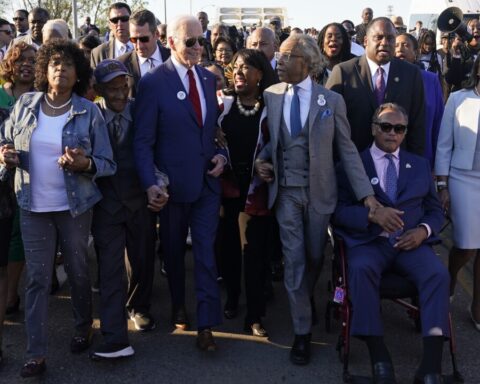President Joe Biden signed a $1.2 trillion infrastructure bill into law Monday, finalizing a key part of his economic agenda.
It will deliver $550 billion of new federal investments in America’s infrastructure over five years, touching everything from bridges and roads to the nation’s broadband, water and energy systems. Experts say the money is sorely needed to ensure safe travel, as well as the efficient transport of goods and produce across the country. The nation’s infrastructure system earned a C- score from the American Society of Civil Engineers earlier this year.
Democrats claim the legislation pays for itself through a multitude of measures and without raising taxes. But the Congressional Budget Office brushed aside several of those pay-for provisions, ultimately finding the package would add $256 billion to the deficit over the next 10 years. It’s significantly smaller than the $2.25 trillion proposal that Biden unveiled in March, known as the American Jobs Plan.
RELATED: 4 projects that could be funded by Biden’s infrastructure package
Here’s what’s in the infrastructure package:
Funding for roads and bridges
The legislation calls for investing $110 billion for roads, bridges and major infrastructure projects. That’s significantly less than the $159 billion that Biden initially requested in the American Jobs Plan.
Included is $40 billion for bridge repair, replacement and rehabilitation, according to the text. The White House says it would be the single, largest dedicated bridge investment since the construction of the interstate highway system, which started in the 1950s.
The deal also contains $16 billion for major projects that would be too large or complex for traditional funding programs, according to the White House.
Some 20%, or 173,000 miles, of the nation’s highways and major roads are in poor condition, as are 45,000 bridges, according to the White House.
The investments will focus on climate change mitigation, resilience, equity and safety for all users, including cyclists and pedestrians.
Also in the package is $11 billion for transportation safety, including a program to help states and localities reduce crashes and fatalities, especially of cyclists and pedestrians, according to the White House. It will direct funding for safety efforts involving highways, trucks, and pipeline and hazardous materials.
And it contains $1 billion to reconnect communities — mainly disproportionately Black neighborhoods — that were divided by highways and other infrastructure, according to the White House. It will fund planning, design, demolition and reconstruction of street grids, parks or other infrastructure.
Money for transit and rail
The package provides $39 billion to modernize public transit, according to the text. That’s less than the $85 billion that Biden initially wanted to invest in modernizing transit systems and help them expand to meet rider demand.
The funds will repair and upgrade existing infrastructure, make stations accessible to all users, bring transit service to new communities and modernize rail and bus fleets, including replacing thousands of vehicles with zero-emission models, according to the White House.
The deal will also invest $66 billion in passenger and freight rail, according to the text. The funds would eliminate Amtrak’s maintenance backlog, modernize the Northeast Corridor line and bring rail service to areas outside the Northeast and mid-Atlantic regions, according to the White House. Included in the package is $12 billion in partnership grants for intercity rail service, including high-speed rail.
The funding is less than the $80 billion Biden originally wanted to send to Amtrak, which he relied upon for decades to get home to Delaware from Washington, DC.
Still, it would be the largest federal investment in public transit in history and in passenger rail since the creation of Amtrak 50 years ago, according to the White House.
Broadband upgrade
The legislation provides a $65 billion investment in improving the nation’s broadband infrastructure, according to the text. Biden initially wanted to invest $100 billion in broadband.
It also aims to help lower the price households pay for internet service by requiring federal funding recipients to offer a low-cost affordable plan, by creating price transparency and by boosting competition in areas where existing providers aren’t providing adequate service. It will also create a permanent federal program to help more low-income households access the internet, according to the White House fact sheet.
Upgrading airports, ports and waterways
The deal will invest $17 billion in port infrastructure and $25 billion in airports to address repair and maintenance backlogs, reduce congestion and emissions near ports and airports and promote electrification and other low-carbon technologies, according to the White House.
It is similar to the funding in Biden’s original proposal.
Electric vehicles
The legislation will provide $7.5 billion for zero- and low-emission buses and ferries, aiming to deliver thousands of electric school buses to districts across the country, according to the White House.
Another $7.5 billion will go to building a nationwide network of plug-in electric vehicle chargers, according to the text.
Improving power and water systems
The package invests $65 billion to rebuild the electric grid, according to the White House. It calls for building thousands of miles of new power lines and expanding renewable energy, the White House said.
It provides $55 billion to upgrade water infrastructure, according to the text. It will replace lead service lines and pipes so that communities have access to clean drinking water, the White House said.
Another $50 billion will go toward making the system more resilient — protecting it from drought, floods and cyberattacks, the White House said.
Environmental remediation
The package provides $21 billion to clean up Superfund and brownfield sites, reclaim abandoned mine land and cap orphaned gas wells, according to the White House.
How Congress will pay for it
The legislation includes a multitude of measures to pay for the proposal — none of which would raise taxes.
But while lawmakers claim the package pays for itself, the CBO score found it would instead add billions of dollars to the deficit over 10 years and that many of the pay-for provisions would not raise as much money as Democrats said they would.
The bottom line is that the legislation would directly add roughly $350 billion to the deficit, when taking into account $90 billion of spending in new contract authority, said Marc Goldwein, senior vice president at the Committee for a Responsible Federal Budget, a nonpartisan group that tracks federal spending.
According to the text and a 57-page summary of the legislation, lawmakers leaned heavily on repurposing unused Covid-19 relief funds to pay for the legislation. The CBO found these measures would provide roughly $22 billion in savings, rather than the roughly $263 billion claimed by lawmakers, Goldwein said.
The text lists savings from rescinding unobligated appropriations for the Economic Injury Disaster Loan program for small businesses and nonprofit groups, the Paycheck Protection Program, the Education Stabilization Fund and relief for airline workers, among others.
Another item in the text is $53 billion that stems in part from states opting to terminate the pandemic unemployment benefits early in hopes of pushing the jobless to return to work. Some 24 states stopped at least one of the federal unemployment programs before they officially ended in early September. Also, the CBO reduced its forecast for the unemployment rate because of the improving economy.
The agency also found that the Federal Communications Commission’s spectrum auctions would generate far less than the $87 billion originally claimed by lawmakers.
The CBO also said that the legislation will raise about $50 billion by imposing new Superfund fees and changing the tax reporting requirements for cryptocurrencies, among other measures.
More savings would come from delaying a controversial Trump administration rule that would radically change how drugs are priced and paid for in Medicare and Medicaid until 2026, at the earliest. The measure will effectively ban drug makers from providing rebates to pharmacy benefit managers and insurers. Instead, drug companies will be encouraged to pass the discounts directly to patients at the pharmacy counter. It is currently expected to go into effect in 2023. The summary lists the savings as $49 billion and the CBO report as nearly $51 billion.
Also, the infrastructure package relies on generating $56 billion in economic growth resulting from a 33% return on investment on the long-term projects, according to the summary.
Biden has said that the legislation won’t raise taxes on people making less than $400,000 a year and does not include a gas tax increase or fee on electric vehicles. He initially called for raising taxes on corporations to fund the infrastructure investments — but that proposal did not make it into the final package after strong opposition from Republicans.
What’s missing
The package leaves out Biden’s proposal to spend $400 billion to bolster caregiving for aging and disabled Americans — the second largest measure in the American Jobs Plan.
His proposal would have expanded access to long-term care services under Medicaid, eliminating the wait list for hundreds of thousands of people. It would have provided more opportunity for people to receive care at home through community-based services or from family members.
It would also have improved the wages of home health workers, who now make approximately $12 an hour, and would have put in place an infrastructure to give caregiving workers the opportunity to join a union.
Also left on the sideline: $100 billion for workforce development, which would have helped dislocated workers, assisted underserved groups and put students on career paths before they graduate high school.
The legislation also leaves out the $18 billion Biden proposed to modernize Veterans Affairs hospitals, which are on average 47 years older than private-sector hospitals.
What’s also out is a slew of corporate tax hikes that Biden wanted to use to pay for the American Jobs Plan.
Biden’s original proposal called for raising the corporate income tax rate to 28%, up from the 21% rate set by Republicans’ 2017 tax cut act, as well as increasing the minimum tax on US corporations to 21% and calculating it on a country-by-country basis to deter companies from sheltering profits in international tax havens.
It also would have levied a 15% minimum tax on the income the largest corporations report to investors, known as book income, as opposed to the income reported to the Internal Revenue Service, and would have made it harder for US companies to acquire or merge with a foreign business to avoid paying US taxes by claiming to be a foreign company.
There are some corporate tax raising provisions that Democratic lawmakers are looking to include in the separate legislation aimed at expanding the nation’s social safety net.







